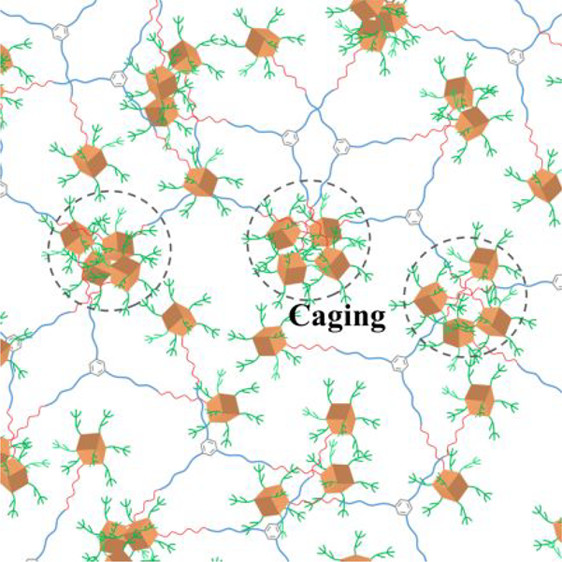
Covalent bonding and/or supramolecular interaction among materials’ structural units are, generally, key to the realization of promising mechanical performance while the understanding on the physical interaction from the structural units’ topologies is poor. Herein, in the supramolecular interaction-free systems of the assemblies of sub-nanoscale isooctyl-functionalized polyhedral oligomeric silsesquioxane (OPOSS), topological interaction contributes dominantly to their viscoelasticity with broad tunability far above their glass transition temperatures. The assembly molecules are designed with dumbbell, triangle and tetrahedron shapes, respectively and they demonstrate intrinsic glassy feature with neither long range ordering nor supramolecular assembly formations in their bulks. Interestingly, their viscoelasticity can be broadly tuned through the tailoring of molecular topologies while the trimer and tetramer assemblies afford elastic moduli comparable to rubbers as ca. 0.5 MPa even at 80 K above their glass transition temperatures. Molecular dynamics studies reveal the topological constraints resulting from the topology-disrupted cooperative dynamics among the cluster assemblies and this finally leads to typical caging dynamics of the structural units and the elasticity of bulk materials. Further broadband dielectric spectroscopy studies uncover the unique hierarchical relaxation dynamics, inspiring the strategy for the decoupling of mechanical strengths and toughness for the design of impact resistance materials.
一般来说,材料的结构单元之间的共价键和/或超分子相互作用是实现有理想机械性能的关键,而对结构单元的拓扑结构的物理相互作用的理解却很欠缺。在此,在亚纳米级异辛基功能化多面体低聚硅氧烷(OPOSS)组装的无超分子相互作用系统中,拓扑结构的相互作用对其粘弹性有很大的贡献,在远高于其玻璃转化温度具有广泛的可调性。组装分子分别被设计成哑铃形、三角形和四面体的形状,它们表现为玻璃态,既没有长程排序也没有超分子组装形成。有趣的是,它们的粘弹性可以通过分子拓扑结构的调整而得到广泛的调节,而三聚体和四聚体组合的弹性模量可与橡胶相媲美,即使在高于其玻璃转化温度80K时也是如此。分子动力学研究显示,拓扑结构限制来源于由分子簇组装体之间的拓扑结构被破坏的合作动力学,这最终导致了结构单元的典型笼状动力学和批量材料的弹性。进一步的宽带介电光谱研究揭示了材料独特的分层松弛动力学,激发了设计抗冲击材料的机械强度和韧性的解耦策略。
文章信息:
Zhou, X.; Yang, J.*; Yang, J.; Yin, P.* Topological Interaction among Molecular Cluster Assemblies Affords Tunable Viscoelasticity. J. Phys. Chem. Lett.2022, 13, 7009-7015. (https://pubs.acs.org/doi/10.1021/acs.jpclett.2c01817)

